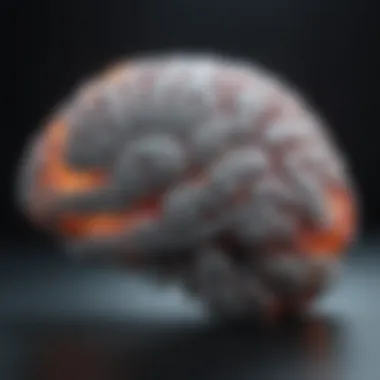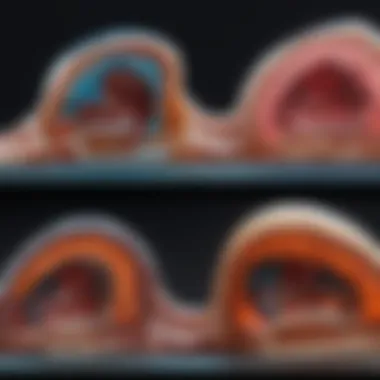Understanding PET Scan Pictures: Insights and Analysis


Intro
Positron Emission Tomography (PET) scans have revolutionized the field of medical imaging. They provide crucial insights into physiological processes and help diagnose various conditions with remarkable accuracy. Understanding the images produced by PET scans can significantly enhance the decision-making process in medical treatment. This first section sets the stage for a deeper analysis of PET scan technology and images, illuminating their relevance in diagnosing and planning treatment.
In this article, we will dissect the fundamental components of PET scans, how the images are interpreted, and their applications in healthcare. The aim is to equip readers with a thorough understanding of these important tools in medical diagnostics.
As we delve into this topic, we will explore the technology behind PET scans, the significance of the data they provide, and the ways these images guide treatment paths for patients. Given the complexity and critical nature of medical imaging, this exploration will aid students, researchers, educators, and professionals in grasping the intricate relationship between technology and healthcare.
Intro to PET Scans
Positron Emission Tomography, commonly known as PET scanning, represents a profound advancement in the field of medical imaging. Understanding PET scans is important because these images provide a unique look at the body’s metabolic activity, offering insights that traditional imaging techniques often miss. As medical technology evolves, the role of PET scans in diagnostics and treatment planning has grown, placing it at the forefront of modern medicine.
Definition and Purpose
PET scans are imaging tests that use radioactive substances to visualize metabolic processes in the body. This method differs significantly from traditional imaging such as X-rays or CT scans, which primarily show structural details. The purpose of a PET scan is to detect disease, assess the effectiveness of treatment, and monitor changes in metabolic functioning.
The imaging process involves administering a radiotracer, a compound that emits positrons. These positrons interact with electrons in the body, producing gamma rays. A PET scanner detects these rays and constructs images based on the distribution of the radiotracer. This process helps to identify abnormalities in tissues or organs that may not be visible with other imaging modalities.
Using PET scans can lead to early detection of conditions, especially cancers, enabling timely interventions and potentially improving patient outcomes. This capability is invaluable for clinicians when deciding on the most effective treatment strategies.
Historical Background
The history of PET scanning begins in the 20th century, with foundational work in nuclear medicine. Key advancements came in the late 1970s when the first clinical PET scanner was developed. These early devices were rudimentary, yet they set a precedent for the technology we use today.
In the following decades, PET technology underwent significant refinements, including changes in radiotracer chemistry and imaging systems. The integration of PET with CT imaging in the early 2000s was a major milestone. This hybrid approach allows for concurrent anatomical and functional imaging, providing a more comprehensive examination of the body. As a result, PET/CT has become a standard tool in oncology, cardiology, and neurology, underscoring the importance of PET scans in contemporary medical practice.
"PET scans continue to pave the way for understanding complex metabolic changes in various health conditions and are essential in guiding therapeutic decisions."
In summary, the areas covered in the introduction to PET scans underline their significance as a diagnostic tool. The continuing advancements in imaging technology will likely enhance their relevance and application in diverse medical fields.
The Science Behind PET Scanning
The significance of The Science Behind PET Scanning lies in its ability to elucidate the complex processes that enable positron emission tomography to create detailed images of biological functions. This knowledge is crucial for students, researchers, educators, and professionals involved in the medical and imaging fields. By understanding the scientific principles and mechanisms at play, one can appreciate the technological advancements that have transformed medical diagnostics and treatment planning.
Positron Emission Tomography has become a cornerstone of modern medical imaging. It relies on the principles of nuclear physics and biology to produce images that reveal metabolic processes within the body. As such, grasping these scientific fundamentals not only enhances our ability to interpret PET scan pictures but also informs clinical decision-making.
Basic Principles of Positron Emission Tomography
Positron Emission Tomography or PET scanning operates based on the detection of gamma rays resulting from positrons emitted by radiotracers. When a radiotracer is injected into a patient, it travels through the bloodstream and accumulates in specific tissues. The radiotracer, usually a form of glucose tagged with a radioactive isotope, emits positrons as it decays.
Once these positrons encounter electrons in the body, they annihilate each other, resulting in the release of two gamma photons. These photons travel in opposite directions and are detected by the PET scanner. By analyzing the data from these gamma photons, a computer reconstructs images representing areas of increased metabolic activity. Thus, PET is exceptional in providing insights into how tissues function rather than just their structure.
Radiotracers: The Heart of PET Imaging
Radiotracers are critical components of PET imaging. Their role cannot be overstated as they provide the necessary information about physiological functions. Radiotracers used in PET scans must be safe and effective, which is why the choice of compound is significant.


The most commonly used radiotracer is fluorodeoxyglucose (FDG), which mimics glucose, a principal energy source for cells. Since cancer cells typically consume glucose at a higher rate, FDG is particularly useful in oncology for identifying malignant tumors. However, the variety of radiotracers is not limited to FDG. Different tracers target various biological processes, such as brain activity, blood flow, and receptor binding, expanding the applicability of PET scans across multiple medical fields.
In summary, The Science Behind PET Scanning encompasses the fundamental principles of how PET works and the pivotal role of radiotracers. A comprehensive knowledge of these elements is essential for effective diagnosis and treatment in modern healthcare.
How PET Scans Work
Understanding how PET scans work is crucial for grasping their importance in medical imaging. This section elucidates the steps involved in preparing for a PET scan, undergoing the scanning process, and what happens after the scan is completed. Each step is designed to enhance the accuracy of the scans while ensuring patient safety and comfort.
Preparation for a PET Scan
Proper preparation is essential for obtaining clear and accurate results from a PET scan. Patients often need to follow specific instructions leading up to the scan. It usually starts with dietary restrictions. Patients are often advised to fast for several hours before the procedure, typically six to eight hours. This fasting helps to ensure that the radiotracer can be absorbed effectively, leading to improved imaging results.
In addition to fasting, clinicians may recommend avoiding certain medications that could interfere with the scan. Patients should inform their doctors about all medications and supplements they are taking. It's also important to consult the medical professional regarding any allergies, especially to contrast agents or sugars.
Patients should wear comfortable, loose-fitting clothing free of metal. Jewelry, belts, and other accessories should be removed as they may interfere with the imaging process. Moreover, before the scan, healthcare providers might conduct preliminary tests, like blood work, to assess general health and ensure the individual is fit for the procedure.
The Scanning Process
The scanning process of a PET scan itself is relatively straightforward yet highly sophisticated. Once prepared, the patient will be injected with a radiotracer, which is a small amount of radioactive material. This substance is designed to highlight areas of concern in the body. The choice of radiotracer depends on the type of imaging required. For instance, fluorodeoxyglucose (FDG) is commonly used in oncology to detect cancerous tissues because cancer cells tend to absorb sugar more avidly than normal cells.
After the injection, the patient typically waits for a period, often about 30 to 60 minutes. This wait allows the radiotracer to circulate through the body and be absorbed by the tissues. The next step involves the patient lying on a scanning bed, which will move through the PET scanner.
During the scan, which generally lasts around 20 to 40 minutes, the scanner detects radiation emitting from the radiotracer. The information gathered is then used to create images that represent the metabolic activity in the body. Patients are often instructed to remain still during this time to avoid blurring the images.
Post-Scan Procedures
Post-scan procedures are critical in understanding the results and ensuring safety. After the scan, patients can typically resume normal activities, including eating and taking prescribed medications. It is encouraged to drink plenty of fluids, as this helps flush out the radiotracer from the body.
Medical professionals often review the images shortly after the scan, but a comprehensive analysis may take more time. Patients will usually be scheduled for a follow-up appointment to discuss the results with their healthcare provider. During this consultation, the significance of the findings will be explained, linking them back to the patient's symptoms and medical history.
"It is vital for patients to understand the process, not only for their peace of mind but also for informed discussions with their healthcare providers."
The entire process, from preparation to post-scan care, ensures that PET scans are conducted safely and effectively, leading to better diagnostic insights.
Interpreting PET Scan Pictures
Interpreting PET scan pictures is a crucial component of understanding how this technology contributes to modern medicine. PET scans provide insights into metabolic activity, which can reveal important information about a patient's health. By examining these images, healthcare professionals can make informed decisions regarding diagnosis, treatment planning, and patient follow-up.
Understanding Image Representation
PET scan images represent metabolic processes within the body. Each color and intensity on the image corresponds to the level of radiotracer uptake in various tissues. High uptake areas often appear bright, indicating increased metabolic activity, while darker regions suggest lower activity. The representation relies heavily on the radiotracer used; common radiotracers include fluorodeoxyglucose (FDG), which is particularly useful in oncology.
Understanding this representation is pivotal for accurate interpretation. Clinicians must be proficient in reading these images, as incorrect readings can lead to misdiagnosis or unnecessary procedures. This level of understanding can also enhance communication between specialists and general practitioners, ensuring that patient care is both timely and appropriate.
Identifying Normal vs. Abnormal Findings
The capacity to distinguish between normal and abnormal findings on PET scans is fundamental. Normal metabolic activity can vary quite substantially among individuals and also across different tissues within the same individual. Commonly, normal brain activity will have specific patterns, which can be contrasted against pathological findings.


Abnormal findings may indicate the presence of conditions such as tumors or infections. For instance, a highly active area in a lung scan could suggest malignancy. Recognizing these patterns requires experiece and knowledge, as a superficial reading could overlook subtle yet critical distinctions.
Healthcare professionals often rely on databases and training to refine their skills in identifying these findings accurately. Moreover, a systematic approach to reading PET scans improves diagnostic accuracy and leads to better patient outcomes.
Role of Radiologists in Interpretation
Radiologists play a central role in the interpretation of PET scan images. With their specialized training, they are equipped to analyze complex imaging data and provide insight into a patient’s status. They utilize advanced software that enables more precise image analysis, highlighting areas of abnormality that might not be visible to the untrained eye.
Furthermore, radiologists collaborate with oncologists, cardiologists, and neurologists to offer a comprehensive picture of the patient’s health. Their interpretative skills not only guide treatment recommendations but also enable multidisciplinary communication. This collaboration is essential, as it often affects the trajectory of patient care, influencing decisions from surgery to imaging follow-ups.
In summary, radiologists' expertise in analyzing PET scans is invaluable in the clinical setting, significantly impacting diagnosis and treatment strategies.
By understanding the role of PET imaging, healthcare providers can leverage these insights to enhance patient care effectively.
Clinical Applications of PET Scanning
PET scanning is pivotal in modern medicine, making significant contributions to various clinical disciplines. Understanding the clinical applications of PET scanning allows professionals to recognize how it enhances diagnostics and impacts treatment options. Each application offers unique benefits that underscore the importance of PET technology in patient care. By employing this imaging technique, physicians can gather critical insights into disease progression and treatment efficacy.
Oncology: Cancer Detection and Monitoring
In oncology, PET scanning serves as a powerful tool for cancer detection and monitoring. This modality is renowned for its ability to visualize metabolic activity in tissues, allowing for more accurate tumor identification. PET scans can detect malignant tumors earlier than some other imaging techniques. They enable clinicians to assess the extent of cancer spread, which is crucial for staging.
The metabolic information provided by PET scans can indicate how well a patient responds to ongoing treatment. For instance, changes in metabolic activity of a tumor during therapy can suggest whether the treatment is effective or if adjustments are necessary. PET's capacity to differentiate between benign and malignant lesions supports better decision-making.
Moreover, ongoing research continues to refine radiotracers, leading to enhanced specificity for different cancer types. This can further improve diagnostic accuracy and allow personalized treatment plans to emerge.
Cardiology: Assessing Heart Function
In cardiology, PET scanning is increasingly utilized for evaluating heart function. It can assess blood flow to the heart, enabling clinicians to identify coronary artery disease. By measuring myocardial perfusion, PET scans provide insight into how well the heart is functioning.
This imaging technique can help determine if a patient's heart muscle is receiving adequate blood and oxygen. Based on the results, doctors can develop appropriate treatment strategies, either with medications or possible surgical interventions.
Furthermore, PET scans can identify viability in heart tissues. This is significant because it allows for distinguishing between living and dead heart tissue after a myocardial infarction. Recognizing viable tissue can guide potential surgical revascularization, thereby improving patient outcomes.
Neurology: Studying Brain Disorders
In the field of neurology, PET scanning plays a crucial role in understanding brain disorders. It provides valuable insights into cerebral metabolism, which can assist in diagnosing conditions like Alzheimer’s disease and Parkinson's disease. The imaging capabilities of PET allow researchers and clinicians to observe the brain's biochemical activity in real time.
For instance, PET scans have shown promises in identifying changes in brain metabolism that correlate with neurodegenerative diseases. Earlier diagnosis leads to earlier treatment, which can be vital in managing symptoms and overall patient quality of life.
Additionally, PET is utilized in studying brain function during specific tasks, helping scientists understand how different areas of the brain interact. This knowledge is essential for developing treatment approaches and understanding the pathology behind various neurological disorders.
"In summary, the use of PET scanning in clinical applications not only promotes precise diagnostics but also supports effective treatment planning across various medical fields."
Through these applications, it becomes clear that PET scanning is integral to advancing healthcare and improving patient outcomes.
Limitations and Challenges of PET Imaging


In medical imaging, positron emission tomography (PET) holds significant value, yet it comes with its own set of limitations and challenges. Understanding these aspects is crucial as they affect clinical decisions and patient outcomes. Patients and healthcare providers must weigh the benefits against the downsides to make informed choices regarding PET scans.
Radiation Exposure Considerations
Radiation exposure is a primary concern with PET imaging. The use of radiotracers introduces a level of ionizing radiation into the body, which can pose health risks, particularly with repeated tests. The radiation dose varies based on the specific radiotracer and protocol used. Although the levels are generally considered safe for diagnostic procedures, the cumulative effects of radiation, especially for patients undergoing multiple scans, warrant careful consideration. In many cases, the potential benefits of accurately diagnosing diseases often outweigh the risks. However, if possible, alternative imaging methods with lower or no radiation exposure, like MRI, may be explored.
Cost and Accessibility
The cost associated with PET imaging can be substantial. This raises important questions about accessibility and how it influences patient care. The expenses include not only the scan itself but also the necessary radiotracers and possibly additional diagnostic procedures. Health insurance coverage for PET scans may vary, creating disparities in who can access this technology. Additionally, PET facilities are not available in all regions, which can limit patient access, particularly in rural or underserved areas. As such, one must consider both economic factors and geographical limitations when evaluating PET imaging as an option for diagnostic purposes.
Technical Limitations in Imaging
Technical challenges in PET imaging can impact the quality of the results. Factors such as the resolution of the imaging equipment and the algorithms used to reconstruct the images play a critical role in clarity and detail. Decreased resolution may lead to difficulties in detecting smaller lesions or differentiating between similar metabolic activities. Moreover, motion artifacts caused by patient movement during imaging can compromise the quality of the scans. Continuous improvements in technology and techniques are ongoing, but these limitations remind us of the need for skilled interpretation and supplementary diagnostic tools.
"Understanding the limitations of PET imaging is as crucial as knowing its advantages. Both aspects play a vital role in effective patient management."
Future of PET Scanning Technology
The future of PET scanning technology is a dynamic field that holds significant promise for enhancing medical imaging. As advancements in technology continue, the implications for diagnostics and treatment planning become increasingly profound. Several areas are of particular importance: the development of new radiotracers, the integration of PET with other imaging techniques, and the utilization of artificial intelligence in image analysis. Each of these elements offers unique benefits and considerations that can influence patient outcomes and the overall effectiveness of PET scans.
Advancements in Radiotracers
Radiotracers play a crucial role in the effectiveness of PET scans. They are substances that emit positrons and are essential for visualizing various physiological processes within the body. Recent advancements in radiotracer technology have led to the development of new agents that can target specific diseases more accurately. For instance, new molecular imaging agents are being designed to identify cancerous cells with higher precision than traditional tracers. This specificity aids radiologists in distinguishing between benign and malignant tumors.
Moreover, advancements in synthetic bioengineering have enabled the production of radiotracers that can mimic natural metabolic processes. These advancements facilitate more accurate imaging of specific organ functions or disease states, presenting a promising direction for future research and application. Furthermore, improvements in isotopic yields and production methods are decreasing costs, making PET scanning more accessible to a greater number of patients.
Integration with Other Imaging Modalities
The integration of PET scanning with other imaging modalities is another important aspect of its future. Combining PET with magnetic resonance imaging (MRI) or computed tomography (CT) creates hybrid imaging systems that provide complementary data. This fusion enhances the precision of diagnoses by combining functional imaging from PET with anatomical details from CT or MRU. Such integrated systems enable healthcare providers to obtain a more comprehensive view of a patient’s condition.
This combination helps in precise localization of abnormalities and improved evaluation of treatment responses. For example, a patient undergoing cancer therapy may benefit from being scanned with both PET and CT to assess not only the metabolic activity of the tumor but also its size and location. As technology evolves, these combined modalities will likely become more common in clinical settings, leading to improved patient pathways and outcomes.
The Role of Artificial Intelligence
Artificial intelligence (AI) is emerging as a transformative force in the analysis of PET scan images. AI algorithms can evaluate large volumes of imaging data quickly and accurately, identifying patterns that may not be immediately apparent to human radiologists. This capability significantly enhances diagnostic accuracy and facilitates personalized treatment plans based on individual patient data.
Machine learning models, particularly, are being trained to recognize and categorize various imaging findings. Their ability to learn from previous cases allows for continuous improvement in accuracy over time. Furthermore, AI can aid in streamlining workflows, reducing the time needed for image interpretation, and ensuring timely patient care.
As the landscape of medical imaging evolves, the integration of AI technologies will likely play a critical role in shaping the future of PET scanning, allowing for enhanced precision in diagnostics and better patient management.
"The advancements in PET scanning and radiotracers promise to revolutionize diagnostic imaging and patient care in the coming years."
Epilogue
In the context of this article, the conclusion serves as a vital synthesis of the information previously examined regarding PET scan pictures. Understanding these scans involves appreciating both their technical foundation and their role within the broader medical landscape. This connection is crucial for students, researchers, educators, and professionals navigating healthcare and imaging.
Recap of Key Points
- PET scans utilize advanced scanning technology to visualize metabolic processes in the body.
- The radiotracers play an essential role in the functionality of PET imaging, illustrating areas of activity or disease.
- Interpretation of PET scan images depends heavily on the expertise of radiologists, as they navigate between normal and abnormal findings.
- Clinical applications extend across various medical fields, such as oncology, cardiology, and neurology, enriching diagnostic capabilities.
- Limitations, including radiation exposure and cost, necessitate careful consideration by both healthcare providers and patients.
- Future developments in PET scanning technology, particularly in radiotracers and artificial intelligence, promise to enhance the precision and effectiveness of this imaging modality.
The Importance of Informed Decisions
Making informed decisions regarding the use of PET scans is essential for optimal health outcomes. Patients, armed with knowledge about how PET imaging works, its applications, and its limitations, can engage in meaningful discussions with their healthcare professionals. This proactive stance is beneficial not only for individual patients but also for advancing the responsible utilization of such advanced imaging technologies across various healthcare settings. As medical imaging continues to evolve, understanding PET scan pictures remains a fundamental aspect of informed healthcare choices.















